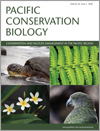
Pacific Conservation Biology
Volume 26 Number 3 2020
PC20053Response to ‘The predominantly fresh history of Lake Alexandrina, South Australia, and its implications for the Murray–Darling Basin Plan: a comment on Gell (2020)'
PC19026Conservation in the wake of myrtle rust – a case study on two critically endangered Australian rainforest plants
 , P. Cuneo, G. Errington, R. O. Makinson, S. Pederson, G. Phillips, A. Rollason, V. Viler and C. A. Offord
, P. Cuneo, G. Errington, R. O. Makinson, S. Pederson, G. Phillips, A. Rollason, V. Viler and C. A. Offord
Myrtle rust is having a devastating impact on some plant species in the Pacific. Ex situ conservation is necessary to preserve those species but their reduced ability to produce viable seeds or healthy new growth is a hindrance. Protocols for conserving severely impacted species are presented; however, susceptible species should ideally be conserved before their growth and reproductive capacity are affected.
PC19026 Abstract | PC19026 Full Text | PC19026PDF (949 KB) Open Access Article
We describe growth (1966–94) and then decline (1995–2017) of noisy scrub-bird populations from Mount Gardner, Western Australia. Decline was not correlated with territory size, rainfall patterns, nor confidently with wildfire in 2015. Inbreeding, translocation history, fire, senescence of vegetation and introduced predators may all contribute to decline patterns.
PC19042A comparison of urban and peri-urban/hinterland nocturnal birds at Brisbane, Australia
Abundance and detectability of owls and other nocturnal birds were compared, over one year, at two Brisbane sites (urban and peri-urban/hinterland/rainforest). Owls were detected only at the peri-urban/hinterland site: these included powerful owl (Ninox strenua), sooty owl (Tyto tenebricosa), masked owl (T. novaehollandiae) and plumed frogmouth (Podargus ocellatus plumiferus).
PC19036An artificial site provides valuable additional habitat to migratory shorebirds in a tropical harbour
 , Danny I. Rogers, Micha V. Jackson, Richard A. Fuller, Gavin O'Brien and Stephen T. Garnett
, Danny I. Rogers, Micha V. Jackson, Richard A. Fuller, Gavin O'Brien and Stephen T. Garnett
Migratory shorebirds that travel the globe every year are highly threatened. Population trends are known at a global scale, but not much is known at the local scale across sites on the non-breeding grounds of Australia. Our paper examines the trends of migratory shorebird species at natural and artificial sites in a tropical harbour. We show that, overall, shorebirds are increasing at both natural and artificial sites.
Historically, information on the little eagle’s breeding habitat, nest-site characteristics and response to human impacts in eastern Australia has been largely anecdotal. This paper identifies baseline requirements for little eagle nesting habitat and provides some suggestions for further conservation management of this vulnerable and declining species.
Environmental offsets are gaining in popularity as a conservation tool to compensate for human-induced negative impacts to biodiversity values. This study investigated offsets in Western Australia applied to mitigate impact to the endangered Carnaby’s cockatoo (Calyptorhynchus latirostris).
PC19038 Abstract | PC19038 Full Text | PC19038PDF (842 KB) | PC19038Supplementary Material (169 KB) Open Access Article
This study focused on a reintroduced population of common brushtail possum (Trichosurus vulpecula hypoleucus) to assess genetic variability and inform management strategies. Inbreeding was lower and heterozygosity was higher in the translocated population than in two of the source populations, endorsing the use of multiple source populations in translocations. This is the first study to document patterns of genetic diversity and to highlight issues with translocation for this subspecies and adds to the limited literature illustrating how outbreeding can be used for conservation purposes.
PC19004High prevalence of non-native fish species in a remote region of the Mamberamo River, Indonesia
Non-native species pose a serious threat to endemic freshwater fauna around the world. Our temporal field survey found that non-native fish are extremely common in the mid Mamberamo River, New Guinea (West Papua), comprising 74% of total catch, with non-native Barbonymus gonionotus (family Cyprinidae) established as the dominant species. In addition, we identified two additional non-native species (Leptobarbus melanopterus and Oreochromis niloticus) that were previously not known from the system.
The lamprey Geotria australis, when provided with appropriate conditions, can be maintained in laboratory tanks for many months from the commencement of the upstream migration through to spawning. Successful maintenance requires, however, the provision of conditions that overcome the potential for this species to succumb to haemorrhagic septicaemia. Spawning, which occurs at the same time as in their natural environment, is described. The prolonged period during which G. australis survive after spawning parallels that recorded for this species in its riverine environment and is unique among lampreys.
PC19027Not yet extinct: Rhynchobatus cooki is found after being unseen for over 20 years
In May 2019 a female specimen of Rhynchobatus cooki was found at Jurong Fishery Port in Singapore. The specimen had been imported from Indonesia. The species had not been seen for over 20 years, and this discovery gives hope that Rhynchobatus cooki is not yet extinct.



